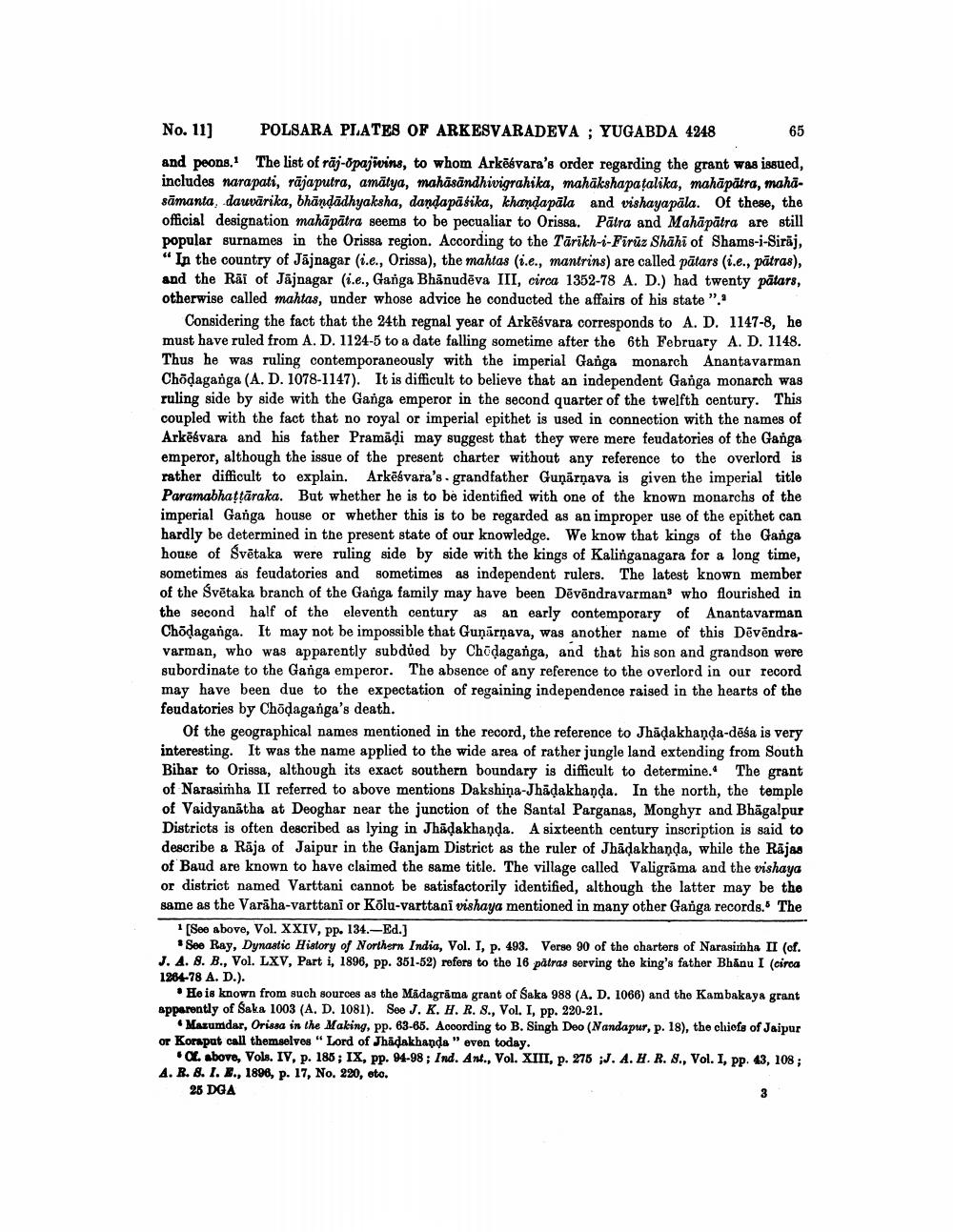________________
No. 11]
POLSARA PLATES OF ARKESVARADEVA; YUGABDA 4248
and peons. The list of raj-opajivins, to whom Arkesvara's order regarding the grant was issued, includes narapati, rājaputra, amatya, mahāsāndhivigrahika, mahākshapaṭalika, mahāpātra, mahāsāmanta, dauvārika, bhāṇḍādhyaksha, danḍapāsika, khandapala and vishayapala. Of these, the official designation mahāpātra seems to be pecualiar to Orissa. Patra and Mahāpātra are still popular surnames in the Orissa region. According to the Tarikh-i-Firuz Shahi of Shams-i-Siraj, "In the country of Jajnagar (i.e., Orissa), the mahtas (i.e., mantrins) are called patars (i.e., pātras), and the Rai of Jajnagar (i.e., Ganga Bhanudēva III, circa 1352-78 A. D.) had twenty patars, otherwise called mahtas, under whose advice he conducted the affairs of his state"
65
Considering the fact that the 24th regnal year of Arkesvara corresponds to A. D. 1147-8, he must have ruled from A. D. 1124-5 to a date falling sometime after the 6th February A. D. 1148. Thus he was ruling contemporaneously with the imperial Ganga monarch Anantavarman Chōdaganga (A. D. 1078-1147). It is difficult to believe that an independent Ganga monarch was ruling side by side with the Ganga emperor in the second quarter of the twelfth century. This coupled with the fact that no royal or imperial epithet is used in connection with the names of Arkesvara and his father Pramaḍi may suggest that they were mere feudatories of the Ganga emperor, although the issue of the present charter without any reference to the overlord is rather difficult to explain. Arkesvara's grandfather Gunārṇava is given the imperial title Paramabhaṭṭāraka. But whether he is to be identified with one of the known monarchs of the imperial Ganga house or whether this is to be regarded as an improper use of the epithet can hardly be determined in the present state of our knowledge. We know that kings of the Ganga house of Svētaka were ruling side by side with the kings of Kalinganagara for a long time, sometimes as feudatories and sometimes as independent rulers. The latest known member of the Svētaka branch of the Ganga family may have been Devendravarman3 who flourished in the second half of the eleventh century as an early contemporary of Anantavarman Chōdaganga. It may not be impossible that Gunārṇava, was another name of this Devendravarman, who was apparently subdued by Chudaganga, and that his son and grandson were subordinate to the Ganga emperor. The absence of any reference to the overlord in our record may have been due to the expectation of regaining independence raised in the hearts of the feudatories by Chōḍaganga's death.
Of the geographical names mentioned in the record, the reference to Jhaḍakhanda-desa is very interesting. It was the name applied to the wide area of rather jungle land extending from South Bihar to Orissa, although its exact southern boundary is difficult to determine." The grant of Narasimha II referred to above mentions Dakshina-Jhadakhanda. In the north, the temple of Vaidyanatha at Deoghar near the junction of the Santal Parganas, Monghyr and Bhagalpur Districts is often described as lying in Jhadakhanda. A sixteenth century inscription is said to describe a Raja of Jaipur in the Ganjam District as the ruler of Jhadakhanda, while the Rājas of Baud are known to have claimed the same title. The village called Valigrama and the vishaya or district named Varttani cannot be satisfactorily identified, although the latter may be the same as the Varaha-varttani or Kōlu-varttani vishaya mentioned in many other Ganga records. The
1 [See above, Vol. XXIV, pp. 134.-Ed.]
See Ray, Dynastic History of Northern India, Vol. I, p. 493. Verse 90 of the charters of Narasimha II (cf. J. A. 8. B., Vol. LXV, Part i, 1896, pp. 351-52) refers to the 16 patras serving the king's father Bhanu I (circa 1264-78 A. D.).
He is known from such sources as the Madagrāma grant of Saka 988 (A. D. 1066) and the Kambakaya grant apparently of Saka 1003 (A. D. 1081). See J. K. H. R. S., Vol. I, pp. 220-21.
Mazumdar, Orissa in the Making, pp. 63-65. According to B. Singh Deo (Nandapur, p. 18), the chiefs of Jaipur or Koraput call themselves "Lord of Jhadakhanda" even today.
CL. above, Vols. IV, p. 185; IX, pp. 94-98; Ind. Ant., Vol. XIII, p. 275 ;J. A. H. R. S., Vol. I, pp. 43, 108; A. R. 8. I. E., 1896, p. 17, No. 220, etc.
25 DGA
3




